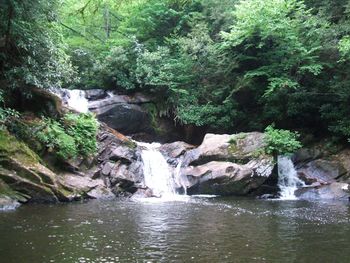Laurel Fork Trail: Difference between revisions
No edit summary |
|||
| Line 29: | Line 29: | ||
== Trail Overview == | == Trail Overview == | ||
<!-- Enter a overview of the trail. What attracts you to this trail, points of interest, types of flowers, lakes, and peaks that you see along the way. --> | <!-- Enter a overview of the trail. What attracts you to this trail, points of interest, types of flowers, lakes, and peaks that you see along the way. --> | ||
Just a short distance up the road from the Laurel Fork Gorge section of the Appalachian Trail. This trail provides a remote path along the Laurel Fork backcountry from Dennis Cove Road to Walnut Mountain Road (of the USFS 50 road system). | |||
The trail is blue-blazed with a number of access points using forest roads. There are two (2) popular waterfalls; Dennis Cove Falls and Upper Laurel Falls. A smaller waterfall can be found along Hays Branch on the eastern end of the trail near Walnut Mountain Road. | |||
The trail also has a historical significance as it follows the grade of the old Laurel Fork Railway which was used to transport timber to Hampton (also known as Braemar) to be cut. During the timber cutting, an area of open fields was created known as Frog Level. Today, Frog Level is used for wildlife food plots and limited horseback riding. | |||
== How to get there == | == How to get there == | ||
Revision as of 09:39, 25 May 2011
| |||||||||||||||||||||||||||||||||||||
Trail Overview
Just a short distance up the road from the Laurel Fork Gorge section of the Appalachian Trail. This trail provides a remote path along the Laurel Fork backcountry from Dennis Cove Road to Walnut Mountain Road (of the USFS 50 road system).
The trail is blue-blazed with a number of access points using forest roads. There are two (2) popular waterfalls; Dennis Cove Falls and Upper Laurel Falls. A smaller waterfall can be found along Hays Branch on the eastern end of the trail near Walnut Mountain Road.
The trail also has a historical significance as it follows the grade of the old Laurel Fork Railway which was used to transport timber to Hampton (also known as Braemar) to be cut. During the timber cutting, an area of open fields was created known as Frog Level. Today, Frog Level is used for wildlife food plots and limited horseback riding.
How to get there
Route Description
The Laurel Fork Trail travels from Dennis Cove Road (across the small bridge from Dennis Cove Recreation Area/Campground) to Walnut Mountain Road and has a number of access points along the way. The trail mostly follows an old railroad grade. But the mainly obstacle along the trail are a number of water fords and lack of blazing as the trail continues upstream.
Typical Conditions
If anything, you will get wet on this trail. Be cautious during periods of high water. This trail has numerous ankle to knee deep fords. With some beaver-dammed areas reaching nearly waist deep. The trail conditions are generally good up until after Dennis Cove Falls.
After Dennis Cove Falls, the trail is less maintained, the creek fords become more difficult, blazing becomes sparse in open-fields around Frog Level, Bitter End, and Walnut Mountain areas, so you will need to be mindful of the route you take.
Fees, Permits, etc.
No fees for day use of trail. Dennis Cove Recreation Area campground is immediately next to the trail which does carry fees.
After the Hike
Misc. Information
Maps
National Geographic Trails Illustrated Map of South Holston Watauga Lakes
Cherokee National Forest Hiking Guide edited by William H. Skelton
Photos

